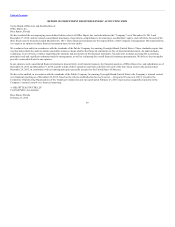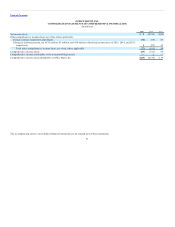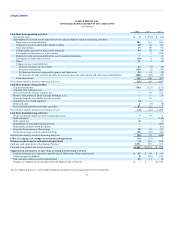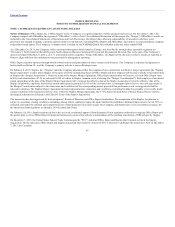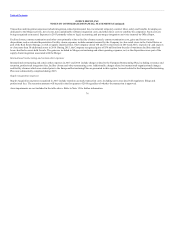OfficeMax 2015 Annual Report Download - page 70
Download and view the complete annual report
Please find page 70 of the 2015 OfficeMax annual report below. You can navigate through the pages in the report by either clicking on the pages listed below, or by using the keyword search tool below to find specific information within the annual report.
Table of Contents
The Company sells selected accounts receivables on a non-recourse basis to an unrelated financial institution under a factoring agreement in France. The
Company accounts for this transaction as a sale of receivables, removes receivables sold from its financial statements, and records cash proceeds when
received by the Company as cash provided by operating activities in the Consolidated Statements of Cash Flows. The financial institution retains a portion
of the sold receivables as a guarantee until the receipt of the proceeds associated with the factored invoices. Retention guarantees of $10 million and $11
million are included in Prepaid expenses and other current assets in the Consolidated Balance Sheets as of December 26, 2015 and December 27, 2014,
respectively.
In 2015 and 2014, the Company withdrew $345 million and $479 million, respectively, under the factoring agreement. Receivables sold for which the
Company did not obtain cash directly from the financial institution are included in Receivables and amount to $6 million as of December 26, 2015 and
December 27, 2014.
: Inventories are stated at the lower of cost or market value and are reduced for inventory losses based on estimated obsolescence and the results
of physical counts. In-bound freight is included as a cost of inventories. Also, cash discounts and certain vendor allowances that are related to inventory
purchases are recorded as a product cost reduction. The weighted average method is used throughout the Company to determine the cost of inventory and the
first-in-first-out method is used for inventory held within certain European countries where the Company has operations.
: Income taxes are accounted for under the asset and liability method. This approach requires the recognition of deferred tax assets and
liabilities attributable to differences between the carrying amounts and the tax bases of assets and liabilities and operating loss and tax credit carryforwards.
Valuation allowances are recorded to reduce deferred tax assets to the amount believed to be more likely than not to be realized. The Company recognizes
tax benefits from uncertain tax positions when it is more likely than not that the position will be sustained upon examination. Interest related to income tax
exposures is included in interest expense in the Consolidated Statements of Operations. Refer to Note 9 for additional information on income taxes.
: Property and equipment additions are recorded at cost. Depreciation and amortization is recognized over the estimated useful
lives using the straight-line method. The useful lives of depreciable assets are estimated to be 15-30 years for buildings and 3-10 years for furniture, fixtures
and equipment. Computer software is amortized over three years for common office applications, five years for larger business applications and seven years
for certain enterprise-wide systems. Leasehold improvements are amortized over the shorter of the estimated economic lives of the improvements or the terms
of the underlying leases, including renewal options considered reasonably assured. The Company capitalizes certain costs related to internal use software that
is expected to benefit future periods. These costs are amortized using the straight-line method over the 3 — 7 year expected life of the software. Major repairs
that extend the useful lives of assets are capitalized and amortized over the estimated use period. Routine maintenance costs are expensed as incurred.
Goodwill is the excess of the cost of an acquisition over the fair value assigned to net tangible and identifiable
intangible assets of the business acquired. The Company reviews goodwill for impairment annually or sooner if indications of possible impairment are
identified. The annual review period for the goodwill is as of the first day of the third quarter. The Company elected to conduct a quantitative assessment of
possible goodwill impairment in 2015. In periods that a quantitative test is used, the Company estimates the reporting unit’s fair value using discounted cash
flow analysis and market-based evaluations, when available. If the reporting unit’s carrying value exceeds its fair value, an impairment charge is recognized
to the extent that the carrying amount of goodwill exceeds its implied fair value. This method of estimating fair value requires assumptions, judgments and
estimates of future performance. The Company may
68



